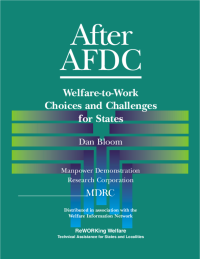After AFDC
Welfare-to-Work Choices and Challenges for States
Passage of the landmark federal welfare reform legislation in 1996 presented states and localities with a set of dramatic and far-reaching choices about how to restructure the public assistance programs that serve some of the nation's most vulnerable families. Published as part of MDRC's ReWORKing Welfare series, this how-to guide draws on the results of dozens of rigorous MDRC studies of state and local innovations that preceded this major shift in national social policy. After AFDC offers policymakers valuable lessons about program approaches that aim to promote work and self-sufficiency, reduce dependency, and improve the well-being of welfare recipients and their children. It reviews current information about four key approaches to welfare reform — welfare-to-work programs, mandatory work programs, policies to change financial incentives, and time limits — and discusses the interactions among these approaches. While the guide does not aim to address the full range of issues that may be involved in a state's welfare reform plans, it identifies broad lessons and trade-offs for states and localities to consider in designing reforms.






